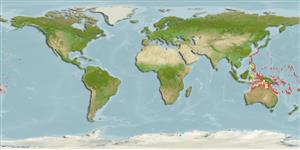Common names from other countries
Klassifizierung / Names
Namen | Synonyme | Catalog of Fishes(Gattung, Arten) | ITIS | CoL | WoRMS | Cloffa
Environment: milieu / climate zone / depth range / distribution range
Ökologie
seewasser riff-verbunden; tiefenbereich 1 - 34 m (Ref. 11890), usually 1 - 12 m (Ref. 90102). Tropical; 30°N - 24°S, 120°E - 170°W (Ref. 74933)
Indo-Pacific: Moluccas and Philippines to Samoa and Tonga, north to the Ryukyu Islands, south to southern Great Barrier Reef; Mariana and Caroline Islands in Micronesia.
Size / Gewicht / Alter
Maturity: Lm ? range ? - ? cm
Max length : 10.0 cm TL Männchen/unbestimmt; (Ref. 9710); common length : 7.7 cm SL Männchen/unbestimmt; (Ref. 37816)
Rückenflossenstacheln (insgesamt): 8; Rückenflossenweichstrahlen (insgesamt): 9; Afterflossenstacheln 2; Afterflossenweichstrahlen: 8. Characterized by having dorsal fin rays VII-I, 9; anal fin rays II,8; pectoral fin rays 13; pelvic fin rays I, 5; pored lateral line scales 24; predorsal scales 3-4; circumpeduncular scales 12 (Ref. 93839); color is coppery or silvery with saddle or bar across the caudal peduncle and a wedge-shaped bar below the eye. Similar to A. fuscus but usually has fewer gill rakers (25-27 versus 28-30). Leading edge of ventral fin clearly pale-blue (Ref. 48635); characterized further by grey caudal peduncle with broad dark bar at base; pale grey at night; greatest depth of body 2.2-2.6 in SL (Ref. 90102).
Occur in outer reef slopes generally at depths below 30 m (Ref. 1602). Nocturnal species (Ref. 7300). Solitary or in small groups (Ref 90102).
Life cycle and mating behavior
Geschlechtsreife | Fortpflanzung | Ablaichen | Eier | Fecundity | Larven
Mouthbrooders (Ref. 240). Distinct pairing during courtship and spawning (Ref. 205).
Myers, R.F., 1991. Micronesian reef fishes. Second Ed. Coral Graphics, Barrigada, Guam. 298 p. (Ref. 1602)
IUCN Rote Liste Status (Ref. 130435)
CITES (Ref. 128078)
Not Evaluated
Bedrohung für Menschen
Harmless
Nutzung durch Menschen
Mehr Information
ReferenzenAquakulturAquakultur ProfilZuchtlinienGenetikElectrophoresesVererbbarkeitKrankheitenVerarbeitungMass conversion
PartnerBilderStamps, Coins Misc.LauteCiguateraGeschwindigkeitSchwimmstilKiemenoberflächeOtolithsGehirngrößeSehfähigkeit
Tools
Zusatzinformationen
Download XML
Internet Quellen
Estimates based on models
Preferred temperature (Ref.
115969): 25.9 - 29.3, mean 28.6 (based on 1393 cells).
Phylogenetic diversity index (Ref.
82804): PD
50 = 0.5020 [Uniqueness, from 0.5 = low to 2.0 = high].
Bayesian length-weight: a=0.01445 (0.00860 - 0.02429), b=3.09 (2.95 - 3.23), in cm Total Length, based on LWR estimates for this species & (Sub)family-body (Ref.
93245).
Trophic level (Ref.
69278): 3.3 ±0.3 se; based on size and trophs of closest relatives
Widerstandsfähigkeit (Ref.
120179): hoch, Verdopplung der Population dauert weniger als 15 Monate. (Preliminary K or Fecundity.).
Fishing Vulnerability (Ref.
59153): Low vulnerability (10 of 100).
